By Gary Simpson
Journal Flashback presents “The Telephone Comes to Ventura,” a snapshot of the evolution of telephone services in the county. While the article itself is now dated, it shows just how much communication technology has changed. The author writing in 1964 reflected on the rapid advent of new telephone technologies since 1889. However, contemporary readers will notice how much technologies have advanced since Simpson penned the article. In the year before the article was written, the telephone company had just upgraded its equipment to allow Ventura area subscribers to directly call other phones in the U.S. and Canada. It makes one wonder if our cell phones and Zoom calls will seem quaint to readers 60 years later. This article is from Volume IX, Issue 4 (August 1964).
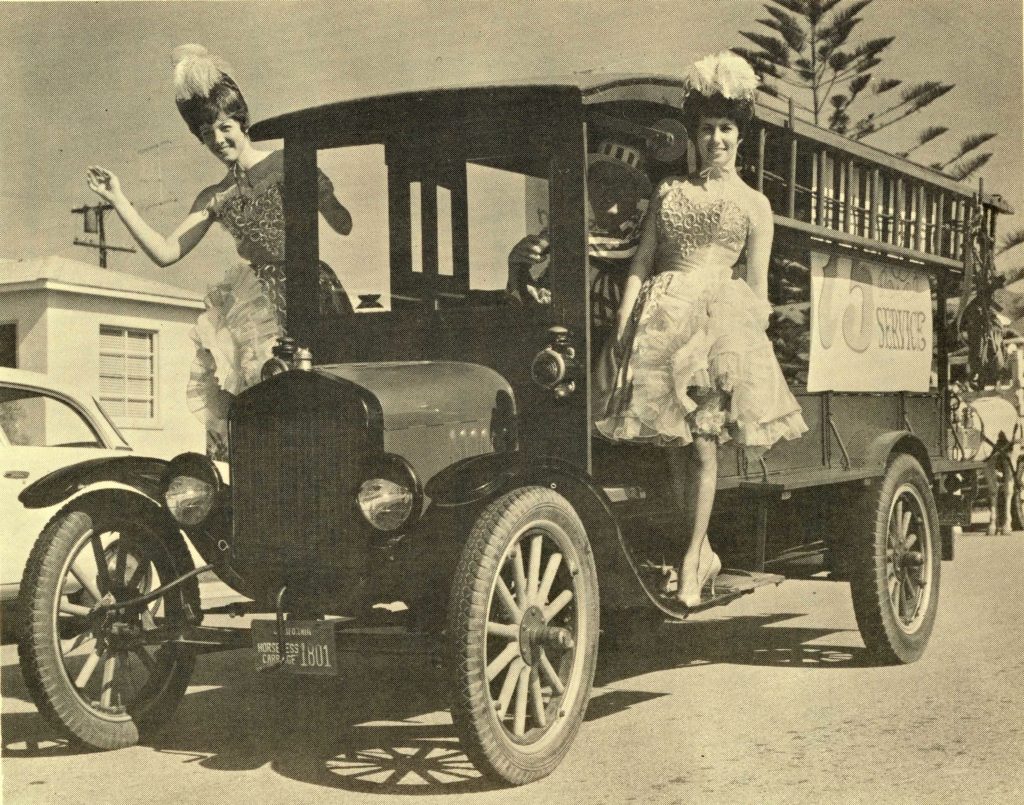
MVC Quarterly Vol. IX, Issue 4 August 1964.
Alexander Graham Bell’s revolutionary new “electricspeaking telephone” was so enthusiastically received by Californians that San Francisco became the third city in the world to open a telephone exchange on February 17, 1878, just two years after the invention’s first successful use. In 1880 the National Bell Company, owners of the original Bell patents and forerunner of the present nationwide Bell System, organized the Pacific Bell Telephone Company with exclusive license to provide service in California, Oregon, Washington, Nevada, Arizona, and a portion of Utah. The following years saw several small companies formed, each privately owned serving separate cities and licensed by Bell headquarters in San Francisco. There had been no attempt to join these scattered systems together by voice since the telegraph had answered the public need fairly well to that time.
By 1883 this was no longer the case, and the Sunset Telephone-Telegraph Company was formed expressly for the purpose of constructing and operating long distance lines to link these distant communities. This new firm absorbed all the smaller companies and, in order to raise funds, issued scripcoupons with which the purchasers could pay toll bills. It was this company which established the first exchange in Ventura under Franchise Ordinance No. 39 dated January 7, 1889. In April of that same year, the Sunset Telephone and Telegraph Company was incorporated with a capital stock of $3 million for the purpose of acquiring the property of the original Sunset company. It did so by issuing the “old” Sunset organization 29,993 shares of its new stock. Later in the year the first Sunset Company was dissolved, and its Sunset Telephone and Telegraph stock was distributed to the shareholders. Since the Pacific Bell Company was the majority stockholder, they thereby also acquired controlling interest in the new Sunset Telephone and Telegraph Company.
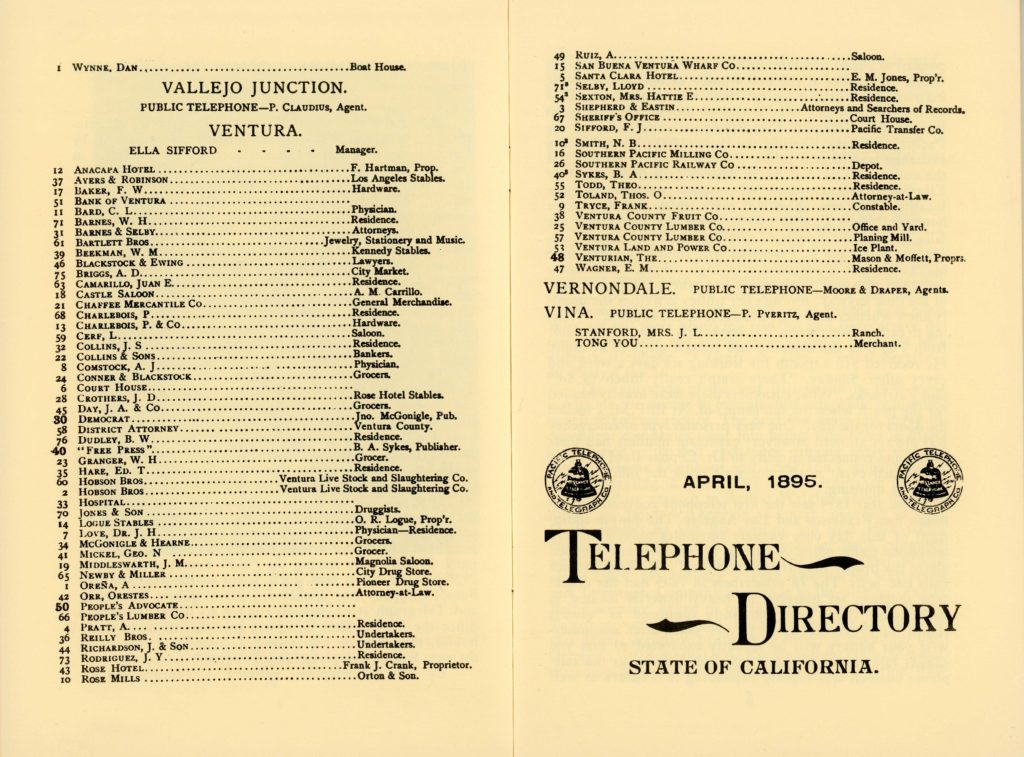
MVC Quarterly Vol. IX, Issue 4 August 1964.
By 1890 the telephone network in Ventura had expanded to a total of 40 subscribers. John I. Sabin and Louis Glass, organizers of the new Sunset Telephone Company, married two Ventura sisters whose family name was Perkins. These two early-day telephone executives went on to become president and vice-president, respectively, of the Pacific Company. During the early 1890s the telephone exchange was located in the Bank of Ventura building at the corner of Oak and Main Streets. It was managed by Ella Sifford who also directed a trolley line from the same location. The two operations were quite complementary however, “since a caller had to crank the phone and ask Ella to reach their party to complete the call anyway,” according to Fergus L. Fairbanks who served as a part-time operator while a sophomore in high school, “Ella knew everyone who had a telephone and where they were most of the time anyway; through her trolley activities she usually knew whether they were available or out of town.” Working to earn pocket money, Fairbanks was Ventura’s operator from 7 to 8 in the morning and from 6 until 10 at night. He received $10 a month for working six days a week and every other Sunday. “There wasn’t really much to do,” said Fairbanks, “What customers there were usually headed for the beach when the sun came out. At 10 P.M. I locked the doors for the day.” One very personal type of emergency was always allowed however: expectant mothers had their telephones connected directly to Dr. Cephas Bard’s in case the blessed event would not wait until the office opened the next morning.
The year 1894 saw the first telephone conversation between San Francisco and Los Angeles. The simple equipment of that day only vaguely resembles today’s modern telephone traffic office. A flap on the switchboard dropped above the proper plug if it were a local call; long distance calls had bells. The 78 subscribers in 1895 had the cranktype magneto set powered by heavy batteries located in each home. Users were constantly cautioned to “always return the instrument to its proper place after use, otherwise your battery will be speedily exhausted so that you cannot talk through your transmitter.” Even so the telephone business was rapidly expanding in Ventura, as well as California. A directory dated March 1899 proclaimed: Wire a man by telegraph and he can avoid or delay reply-Catch him on the telephone and you force an immediate answer! The directory served the Pacific States Long Distance Telephone Companies which included subscribers in California, Oregon, and Washington. Telephone users in Ventura, now 120 strong, were provided many useful bits of information by the volume:
How to Answer a Telephone Call–Remove the hand telephone from the hook and say: “Here is Main 297” (or whatever your number may be.) The party calling should say: “This is Main 298” (or whatever the number may be). Much friction and annoyance will be avoided if this simple plan is carried out.
Since the price of any item or service is traditionally of prime importance in American business, the directory offered: “Of Course You have always had a telephone at your home, but perhaps your relatives or friends have none. Why not tell them about the comfort and convenience derived from same and advise them to get a residence long distance telephone. 5 Cents per Day–Perfect Service–10 Party Line.”
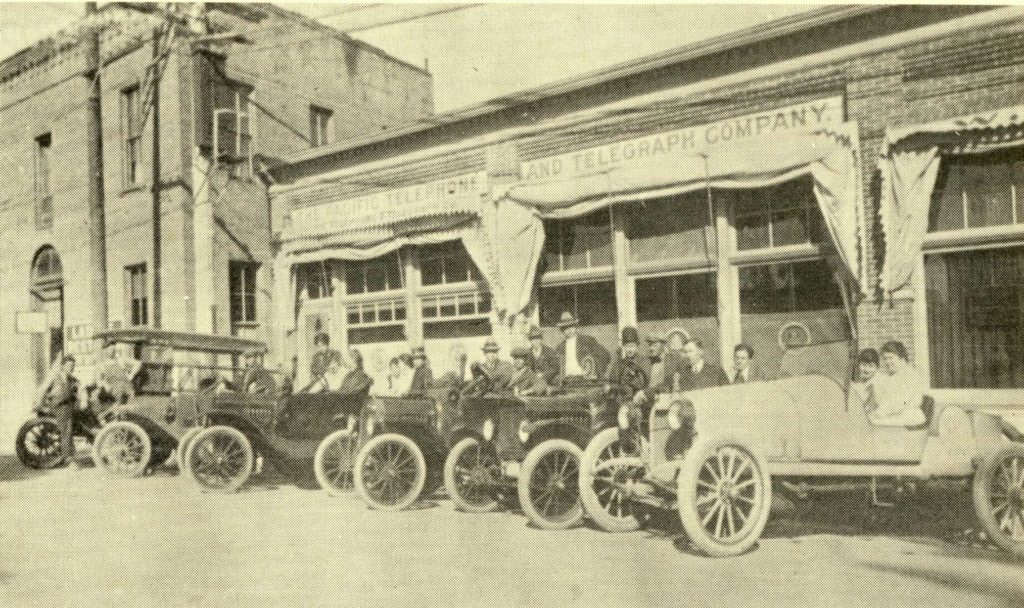
MVC Quarterly Vol. IX, Issue 4 August 1964.
The expiration of the first Bell patent in 1893 made it possible for anyone to manufacture telephone equipment or sell telephone service. The next few years saw many independent companies come into being, sometimes in direct competition with Bell exchanges. Among these was the Ventura Home Telephone and Telegraph Company which began operating in June 1903 under Ordinance No. 124 in a franchise granted to Arthur Wright. About the same time Fred Smith was serving as a night operator in Ojai. Smith reports he lost his evening job soon after taking “unguided steps” to halt the practice of some customers who were using the telephone company as their private alarm clock. On January 2, 1907, the Pacific Telephone and Telegraph Company, successor to the original Pacific Bell Company, began to operate the properties of Sunset Telephone and Telegraph. Pacific Telephone and the Ventura Home company operated in direct competition until October 1, 1918. At that time Pacific bought their independent competitor with the approval of the California Railroad Commission, which was then the regulatory body for public utilities.
In 1910 a major improvement was made in local telephone service with the changeover from magneto-powered sets to a common-battery system. Crews of installer-repairmen began to convert the bulky battery sets in the 490 Ventura homes served by telephone. Power was now supplied by much larger batteries in a centrally located telephone office. It was the beginning of the end for the old familiar crank phone. Although horse-drawn rigs were quickly falling out of style, Pacific Telephone maintained a standing reservation for a good strong team at the James Mack Livery Stable at the corner of Oak and Santa Clara Streets to service outlying subscribers and equipment. Pacific’s telephone office was at this time located at 38 S. Oak Street immediately adjacent to Gibson’s Funeral Parlor. Telephone crews occasionally took time to assist Mr. Gibson with some of his huskier clientele.
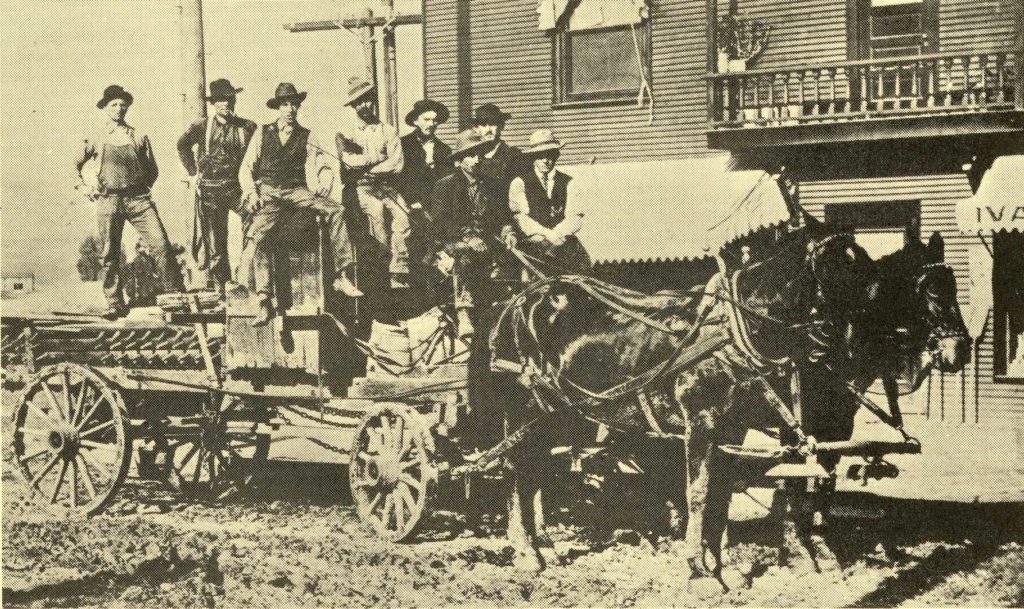
MVC Quarterly Vol. IX, Issue 4 August 1964.
In 1915 the first New York to San Francisco telephone call was made, and transcontinental service was established in ceremonies which featured tones of the Liberty Bell traveling over the line from Philadelphia to be heard in San Francisco. Even at this time Pacific Telephone and Telegraph provided its own long-distance service, while the Ventura Home company was equipped to offer local service only. The latter firm looked to yet another independent company, the United States Long Distance Service, for long distance connections. Louis Sanchez was the Ventura chief operator for U.S. Long Distance which operated from a building just across the alley from Pacific Telephone’s Oak Street location. Until U.S. Long Distance moved into Pacific Telephone’s building with the acquisition of Ventura Home Telephone in 1918, Ventura callers had to tell the operator which of the two toll services they wished to have complete their call.
With the arrival of the Twenties the number of telephones had increased to 950. On August 4, 1922, telephones in Ventura and throughout the United States and Canada were silent for one minute, just before sunset, marking the funeral of Dr. Alexander Graham Bell. Since its inception the telephone has established itself as a symbol of relief in time of emergency. Again, and again, telephone men and women have been called upon to safeguard the well-being, both physical and mental, of a community. Ventura County history has recorded its share of such incidents. Foreman Steve Wilkes vividly recalls losing all his tools and equipment when a recurring shock caught him at the top of a pole desperately trying to restore communications during the 1925 earthquake that demolished much of Santa Barbara. Lineman Ray White, Allen Ambaugh and Steve O’Connell were caught and marooned for hours on the Montalvo Bridge while trying to protect lines during the San Francisquito flood in 1928. The key role telephone men and women played in the rescue and restoration work during and after this catastrophe earned a special citation from Governor Herron. The years have seen many miles of wire laid to keep forestry crews supplied with communications as they battle fires which periodically rage through the area.
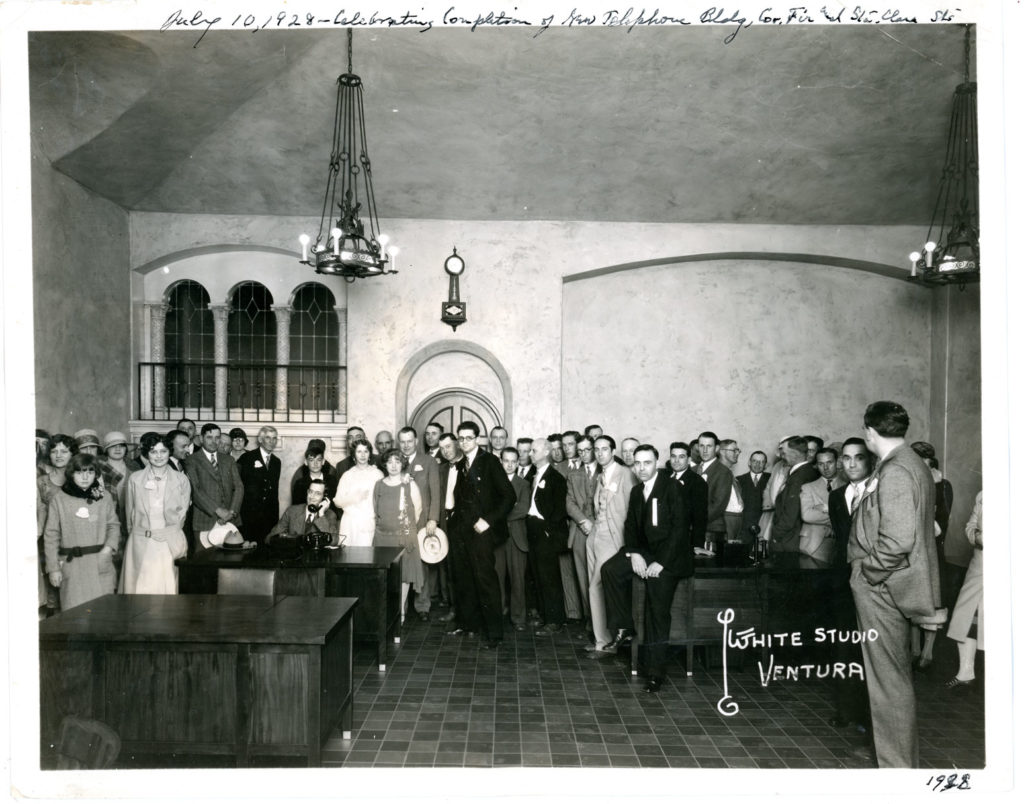
On August 11, 1963, 23,000 Ventura area subscribers were to experience yet another far-reaching innovation in service. Early that morning a switch that literally cost the company $1 million was thrown and from that moment local telephoners were connected directly to 37½ million telephones throughout the United States and Canada through the electro-mechanical marvel known as Direct Distance Dialing. Today Pacific Telephone serves more than 40,000 subscribers throughout Ventura County; and our brief backward glance over the past 75 years seems to have been only a beginning for both Ventura and Pacific Telephone.
